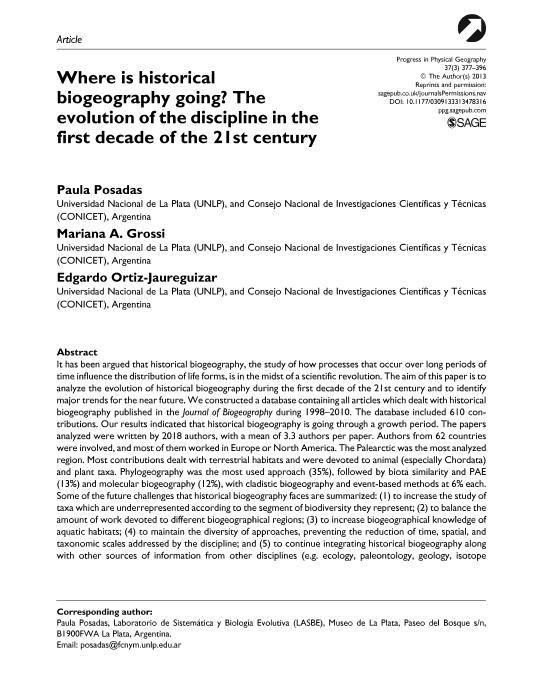Mostrar el registro sencillo del ítem
dc.contributor.author
Posadas, Paula Elena

dc.contributor.author
Grossi, Mariana Andrea

dc.contributor.author
Ortiz Jaureguizar, Edgardo

dc.date.available
2017-08-28T17:44:42Z
dc.date.issued
2013-03
dc.identifier.citation
Posadas, Paula Elena; Grossi, Mariana Andrea; Ortiz Jaureguizar, Edgardo; Where is historical biogeography going? The evolution of the discipline in the first decade of the 21st century; Sage Publications Ltd; Progress In Physical Geography; 37; 3; 3-2013; 377-396
dc.identifier.issn
0309-1333
dc.identifier.uri
http://hdl.handle.net/11336/23113
dc.description.abstract
It has been argued that historical biogeography, the study of how processes that occur over long periods of time influence the distribution of life forms, is in the midst of a scientific revolution. The aim of this paper is to analyze the evolution of historical biogeography during the first decade of the 21st century and to identify major trends for the near future. We constructed a database containing all articles which dealt with historical biogeography published in the Journal of Biogeography during 1998–2010. The database included 610 contributions. Our results indicated that historical biogeography is going through a growth period. The papers analyzed were written by 2018 authors, with a mean of 3.3 authors per paper. Authors from 62 countries were involved, and most of them worked in Europe or North America. The Palearctic was the most analyzed region. Most contributions dealt with terrestrial habitats and were devoted to animal (especially Chordata) and plant taxa. Phylogeography was the most used approach (35%), followed by biota similarity and PAE (13%) and molecular biogeography (12%), with cladistic biogeography and event-based methods at 6% each. Some of the future challenges that historical biogeography faces are summarized: (1) to increase the study of taxa which are underrepresented according to the segment of biodiversity they represent; (2) to balance the amount of work devoted to different biogeographical regions; (3) to increase biogeographical knowledge of aquatic habitats; (4) to maintain the diversity of approaches, preventing the reduction of time, spatial, and taxonomic scales addressed by the discipline; and (5) to continue integrating historical biogeography along with other sources of information from other disciplines (e.g. ecology, paleontology, geology, isotope chemistry, remote sensing) into a richer context for explaining past, present, and future patterns of biodiversity on Earth.
dc.format
application/pdf
dc.language.iso
eng
dc.publisher
Sage Publications Ltd

dc.rights
info:eu-repo/semantics/openAccess
dc.rights.uri
https://creativecommons.org/licenses/by-nc-sa/2.5/ar/
dc.subject
Authorship
dc.subject
Bibliometry
dc.subject
Biogeographical Regions
dc.subject
Biogeography
dc.subject
Historical Biogeography
dc.subject
Scientometrics
dc.subject.classification
Oceanografía, Hidrología, Recursos Hídricos

dc.subject.classification
Ciencias de la Tierra y relacionadas con el Medio Ambiente

dc.subject.classification
CIENCIAS NATURALES Y EXACTAS

dc.title
Where is historical biogeography going? The evolution of the discipline in the first decade of the 21st century
dc.type
info:eu-repo/semantics/article
dc.type
info:ar-repo/semantics/artículo
dc.type
info:eu-repo/semantics/publishedVersion
dc.date.updated
2017-08-23T20:35:49Z
dc.journal.volume
37
dc.journal.number
3
dc.journal.pagination
377-396
dc.journal.pais
Estados Unidos

dc.description.fil
Fil: Posadas, Paula Elena. Universidad Nacional de La Plata; Argentina. Consejo Nacional de Investigaciones Científicas y Técnicas; Argentina
dc.description.fil
Fil: Grossi, Mariana Andrea. Universidad Nacional de La Plata; Argentina. Consejo Nacional de Investigaciones Científicas y Técnicas; Argentina
dc.description.fil
Fil: Ortiz Jaureguizar, Edgardo. Universidad Nacional de La Plata; Argentina. Consejo Nacional de Investigaciones Científicas y Técnicas; Argentina
dc.journal.title
Progress In Physical Geography

dc.relation.alternativeid
info:eu-repo/semantics/altIdentifier/doi/http://dx.doi.org/10.1177/0309133313478316
dc.relation.alternativeid
info:eu-repo/semantics/altIdentifier/url/http://journals.sagepub.com/doi/10.1177/0309133313478316
Archivos asociados
